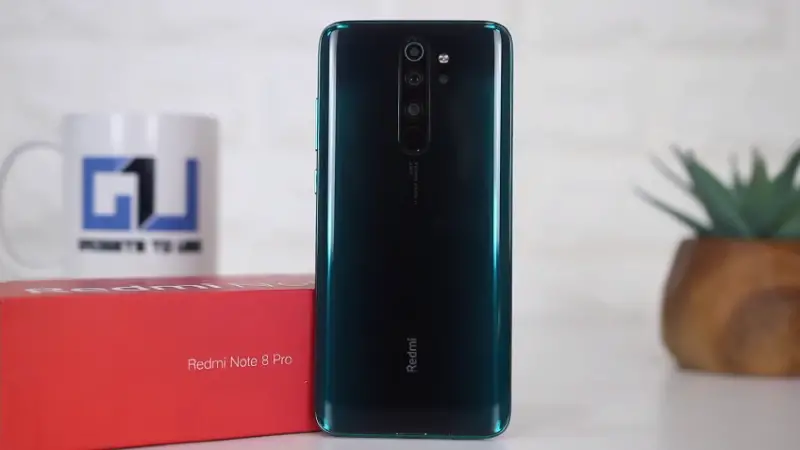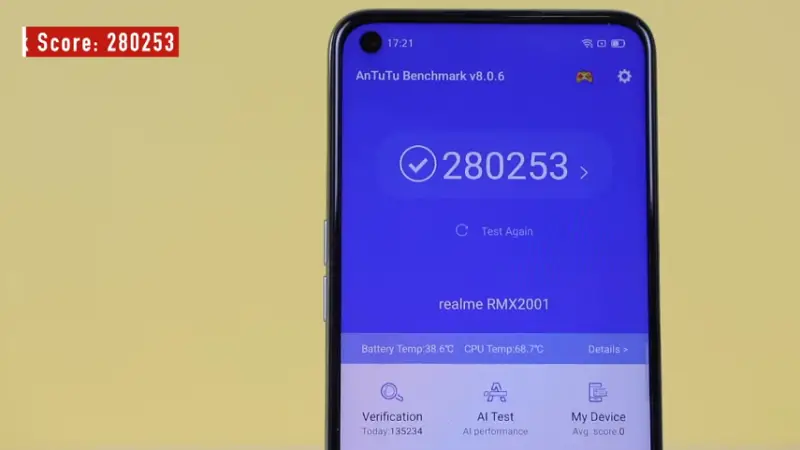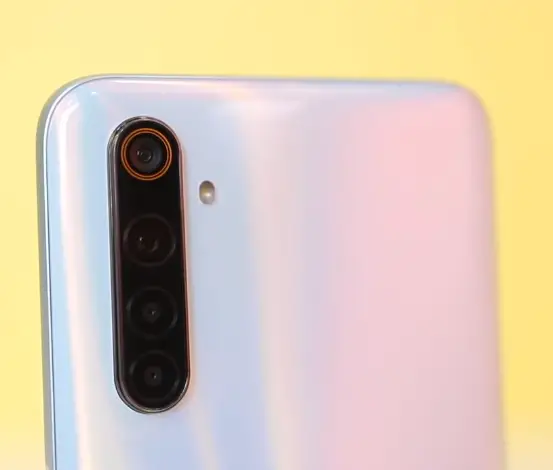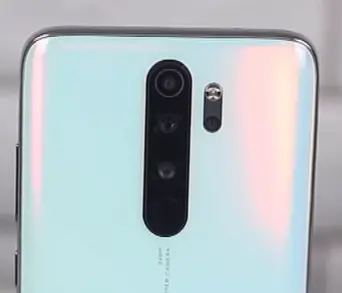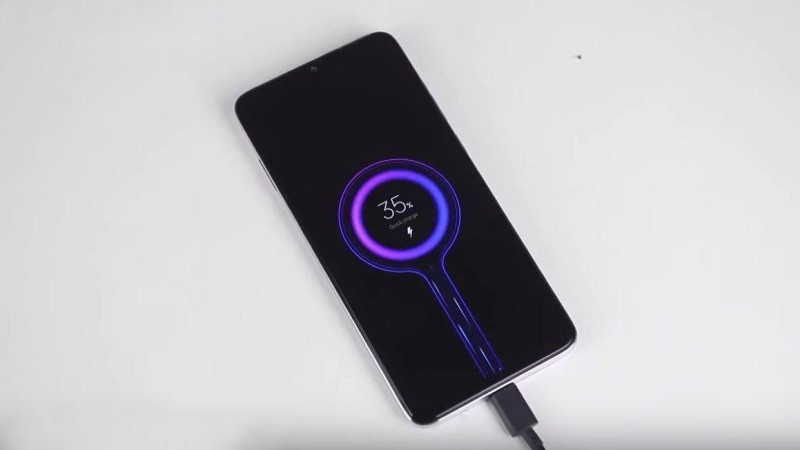Now, given the fact that the former is a dated offering, is it better to go with the Realme? Well, in this article, let’s have a look at detailed Realme 6 vs Redmi Note 8 Pro comparison, concerning specifications, features, and pricing to see which one’s a better buy at the moment.
Realme 6 vs Redmi Note 8 Pro: Comparison
Design: Punch-Hole, Polycarbonate vs Teardrop Notch, Glass Back
For starters, the Realme 6 comes with a polycarbonate back while the Redmi Note 8 Pro offers a glass rear, which gives it a more premium and solid feel. Nevertheless, both have a glossy finish with gradient patterns, with the latter being a tad sober of the duo. Coming over to the front, the Realme 6 gets the modern punch-hole design which looks quite appealing. Whereas, Redmi’s offering, being the dated one here, uses a conventional teardrop notch design. Although, it still offers an immersive experience with minimal side and top bezels.
Note that Realme 6 employs a side-mounted fingerprint scanner, whereas the Note 8 Pro gets a traditional rear-mounted sensor. It also comes with an IR blaster that can double as a universal remote, allowing you to control various household electronic devices. Both the phones have a large form factor with the latter on the marginally heavier side at 200-gram, compared to the other’s 191-gram body. As for the metrics, the Realme 6 measures 162.1 x 74.8 x 8.9mm while the Xiaomi’s Redmi Note 8 Pro measures 161.7 x 76.4 x 8.81mm.
Display: 90Hz vs 60Hz
Notably, the Realme 6 gets a 6.50-inch IPS LCD with a Full-HD+ resolution of 1,080 x 2,400 pixels and an aspect ratio of 20:9. In contrast, the Redmi Note 8 Pro features a 6.53-inch LCD panel having the same Full-HD+ resolution, laid out in a 19.5:9 aspect ratio. It’s worth noting that the display on the Realme 6 comes with a high 90Hz refresh rate compared to Redmi’s regular 60Hz panel. This gives it a sheer advantage in terms of smoother animations and faster overall experience. Like other phones with high refresh rate screens, you do get an option to switch to standard 60Hz mode to save battery life.
Moving further, the pixel density, as well as the screen-to-body ratio, have a negligible difference. Plus, both the devices support Widevine L1 certification, allowing to stream HD content on services like Netflix and Prime Video. However, note that Realme is using older Corning Gorilla Glass 3 in comparison to 8 Pro’s Gorilla Glass 5 protection.
Performance: MediaTek Helio G90T
Both the phones are powered by the same MediaTek Helio G90T, which is an octa-core processor with dual Cortex-A76 cores clocked at 2.05GHz and six Cortex-A55 cores at 2.0GHz. It’s currently one of the best performing mid-range chipsets, giving a sweet edge to both the devices. The Realme 6 is available in 4/64GB, 6/64GB, and 8/128GB RAM and storage models. Whereas, the Note 8 Pro comes in 6/64GB, 6/128GB and 8/128GB RAM and storage options.
Software: RealmeUI vs MIUI
The Realme 6 runs the new RealmeUI on top of Android 10 while the Redmi Note 8 Pro, too, has lately received MIUI 11 based on the latest version. Since Realme has switched over to the RealmeUI from ColorOS, the user interface has become a lot cleaner and close to stock Android. On the contrary, the MIUI feels heavily skinned and intrusive. Anyway, both the UIs are loaded with a lot of bloatware and annoying notifications from system apps, which can be disabled, though.
Cameras: Similar
The Realme 6 features a quad-camera setup at the rear. The same comprises of a 64-megapixel primary sensor with f/1.8 aperture, followed by an 8-megapixel 119-degree wide-angle sensor, a 2-megapixel macro sensor, and a 2-megapixel monochrome sensor. On the front, there is a 16-megapixel f/2.0 shooter for selfies. The Redmi Note 8 Pro also comes with a quad-camera array having a 64-megapixel sensor with f/1.9 aperture as the main unit, accompanied by an 8-megapixel wide-angle shooter and dual 2-megapixel cameras. For selfies, it employs a higher 20-megapixel unit upfront.
Battery & Charging: 30W vs 18W Fast Charging
The Realme 6 comes with a 4,300mAh battery while the Note 8 Pro gets a slightly bigger 4,500mAh cell. While the difference isn’t very significant, the battery life on Realme would feel inferior, especially when used on 90Hz refresh rate mode. Anyway, the former makes up for its smaller capacity by offering 30W VOOC 4.0 flash charging, compared to the latter’s 18W charging prowess. The Note takes about 1 hour 40 minutes to charge from 0 to 100%. Whereas, the Realme 6 juices up from 0 to 70% in 30 minutes and 0 to 100% within an hour, way faster than the competition.
Price: Realme is Cheaper
Realme 6 starts at Rs. 12,999 for the base model with 4GB RAM and 64GB internal storage. Besides, the 6/64GB model costs Rs. 14,999, while the top-end 8/128GB option has been priced at Rs. 15,999. The Redmi Note 8 Pro starts marginally higher at Rs. 13,999 but also offers higher 6GB of RAM and 64GB of internal storage. The 6/128GB and 8/128GB variants retail for Rs. 15,999, and Rs. 17,999, respectively. Realme 6 vs Redmi Note 8 Pro: Which one is better? The Realme 6 evidently outperforms the Redmi Note 8 Pro with its high 90Hz refresh rate display, attractive punch-hole notch, way faster-charging speeds, and of course, the cheaper price tag. However, the Redmi Note 8 Pro hits right back with a tad better battery life, premium glass build, IR blaster, and other quirks, including Gorilla Glass 5 protection and higher resolution selfie camera. In the end, it’s all on your priorities. For us, we’d prefer to have a better-looking phone with a higher refresh rate and faster charging- since that’s what would matter in day to day use. Anyway, some may also opt for the features that the Redmi Note has on offer. Do let us know your choice in the comments below. Also, read- Realme 6 Pro Vs POCO X2: Who is the new king of Rs. 20,000 segment?
